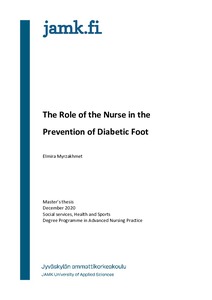The Role of the Nurse in the Prevention of Diabetic Foot
Myrzakhmet, Elmira (2020)
Myrzakhmet, Elmira
2020
All rights reserved. This publication is copyrighted. You may download, display and print it for Your own personal use. Commercial use is prohibited.
Julkaisun pysyvä osoite on
https://urn.fi/URN:NBN:fi:amk-2020121227855
https://urn.fi/URN:NBN:fi:amk-2020121227855
Tiivistelmä
Background: The diabetic foot is a complex of tissue abnormalities observed in the distal legs of diabetic patients. Primary prevention of diabetic foot ulcers focuses on a holistic approach to the management of comorbidities. Prevention of changes in the diabetic foot includes maintaining glycemic control and special foot care. This is important information that the nurse provides in patient education. The assessment knowledge of nurses in the prevention of diabetic foot is important for nurses in Almaty.
Aim: The purpose of the study is to develop recommendations for nurses on counseling patients with type 2 diabetes mellitus for the prevention of diabetic foot.
Methods: Quantitative research was conducted using Webropol (3.0 version) online survey. The Diabetic Foot form tool was used for data collection. The sample consisted of 103 applied bachelors. The data were analyzed using SPSS 26 and descriptive statistics.
Results: 71.8% of the nurses who took part in the survey had not taken advanced training courses in diabetes and foot care. The majority of nurses (63.1%) do not recommend prevention of complications for patients at risk and do not monitor the patient's limbs. Only 28.2% of nurses gave recommendations to their patients and their relatives. Most nurses (78.6%) want additional education on diabetic foot.
Conclusion: Based on the results, regarding nursing knowledge of type 2 diabetes for diabetic foot prevention in the primary health care sector, nurses mainly know the risk factors for diabetic foot but cannot respond to measures to prevent foot complications. The main objective of this study was to uncover nursing knowledge about diabetic foot prevention. Based on the results of the questionnaire it is clear that nurses lack additional knowledge.
Aim: The purpose of the study is to develop recommendations for nurses on counseling patients with type 2 diabetes mellitus for the prevention of diabetic foot.
Methods: Quantitative research was conducted using Webropol (3.0 version) online survey. The Diabetic Foot form tool was used for data collection. The sample consisted of 103 applied bachelors. The data were analyzed using SPSS 26 and descriptive statistics.
Results: 71.8% of the nurses who took part in the survey had not taken advanced training courses in diabetes and foot care. The majority of nurses (63.1%) do not recommend prevention of complications for patients at risk and do not monitor the patient's limbs. Only 28.2% of nurses gave recommendations to their patients and their relatives. Most nurses (78.6%) want additional education on diabetic foot.
Conclusion: Based on the results, regarding nursing knowledge of type 2 diabetes for diabetic foot prevention in the primary health care sector, nurses mainly know the risk factors for diabetic foot but cannot respond to measures to prevent foot complications. The main objective of this study was to uncover nursing knowledge about diabetic foot prevention. Based on the results of the questionnaire it is clear that nurses lack additional knowledge.
